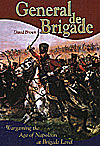 These rules by David Brown (produced by Partizan Press, 816-818, London Road,
Leigh on Sea, Essex, SS9 3NH, UK) declare themselves as "wargaming the Age of Napoleon at Brigade Level", which I am pleased to see because often one is face with rules, or used to be, in which the era of history seemed paramount rather than the organization used by the fighters involved. For your 8.00 pounds you get 54 pages, including the covers and including a four page care "pull out" section.
These rules by David Brown (produced by Partizan Press, 816-818, London Road,
Leigh on Sea, Essex, SS9 3NH, UK) declare themselves as "wargaming the Age of Napoleon at Brigade Level", which I am pleased to see because often one is face with rules, or used to be, in which the era of history seemed paramount rather than the organization used by the fighters involved. For your 8.00 pounds you get 54 pages, including the covers and including a four page care "pull out" section.
In the introduction, David Brown acknowledges help from Steve Payne, the Loughton Strike Force, and Taunton Wargames Society for playtesting over a couple of years. David goes on to say why he costructed these particular rules. We all know the reasons others were too complicated, time consuming or aimed at army level control or skirmishes - or a split between the two. These rules, David says, allow the player freedom to command and maneuver battalions or squadrons but also, "includes higher command decisions such as bridade objectives, the timing of assaults and the deployment of reserves." He also sensibly points out, "obviously simplicity means that all aspects of Napoleonic warfare can be covered and players should therefore try to resolve any problems in a sensible and friendly manner. When not playing solo if the application of common sense isn't enough, the friends I wargame with use a D6. If it falls 1-2-3, one side gets the decision; if 4-5-6, the other does and the problem is resolved. As Brigadier Young used to say "War is an Art, not a Science", and that goes for wargaming too.
The second section deals with Scales, Base Sizes and Dice. Base sizes are not vital to the game but suggestions are given which look good and makes life easier. Equipment - two six-sided dice, markers for brigade orders and pen/pencil and paper for casualties or markers.
Troop types and formations: Guard, Elite, Line, Conscript, Cossacks, 2nd Class Artillery (There seems to be no mention of 1st class artillery, of which Britain had a good amount: i.e. Bull, Mercer and Whinyates - off the top of me head). National characteristics are left out. Squaddie, when it comes down to it, it depends on the equipment he's given and how he's organized and led. Infantry and cavalry formations; unit organization, and Unit Strength (i.e. gun models always have four crews - and a rough guide to line battalion strengths by nation.
The CinC; Brigade Generals and Brigades: Each player fields a division and so is the CinC Division leader. The Division consists of from four to eight brigades, each commanded by a Brigadier represented by a figure. The CinC issues orders and each Brigadier will position, maneuver and order to charge individuals units. Useful information is given on Brigade structure, how many Brigade Generals to have, Brigade formation, Deployment on the table and the historical equivalent. Changing Brigade Orders; Brigade General Initiative; Lose of Nerve (!); creating New Brigades in Battle; Assuming Command of Leaderless Brigades and Notes on Command and Control - all designed to make you behave historically and not have the control you would like to have.
The Game Turn - This gives eight phases which are taken in order - either in turn or simultaneously by the players. The initiative can be gained at the start by rolling 2D6. The winner represents he who gets his act together first. Charges - Procedure and restrictions, evading and opportunity charges. Movement Tables, formation changes, Interpenetration. Terrain - Good, difficult, bad, villages, visibility and the battlefield. Firing - Tables, casualties, infantry, cavalry and artillery firing and ranges. Rockets (the latter can do you more harm than good). Skirmishers - two types: skirmish screens of Brigades and Light Battalions deployed as skirmishers (Read Oman's "Wellington's Army 18091814" Napoleonic Library No. 4, Greenhill Books for good information on skirmisher uses by both sides.
Melee - Procedure and tables; casualties, post melee (with an example). Morale Test Definitions (i.e., charge/counter-charge. Units may charge or countercharge, etc). Optional Rules Desperate charge: The CinC may lead one desperate charge during the course of the game (sounds like me - rallying two line infantry, one matrons and a dog!). Other interesting options are ammo supply, weather, smoke and redoubts. Double Six and Risk To Generals - Roll 11-12, pocket watch hit upset but otherwise unharmed. Cave Generals who roll less than "4" are removed from play. CinC's can be replaced, eventually however. Victory and Defeat - Usually obvious but a points system is given for "close run things." Orders of Battle - A couple of historical examples. The Battle of Maria 15, June 1809 - A scenario by Mike Oliver originally in "Age of Napoleon No 17".
A good set of rules, which I have read through but not play tested. I intend to ASAP as I have a Peninsular setup - and also some Austrians gathering dust who need to be fielded. Well presented and easily understood, uncomplicated and refreshingly like a game! Take a look yourself.
Back to MWAN #88 Table of Contents
Back to MWAN List of Issues
Back to MagWeb Magazine List
© Copyright 1997 Hal Thinglum
This article appears in MagWeb (Magazine Web) on the Internet World Wide Web.
Other military history articles and gaming articles are available at http://www.magweb.com